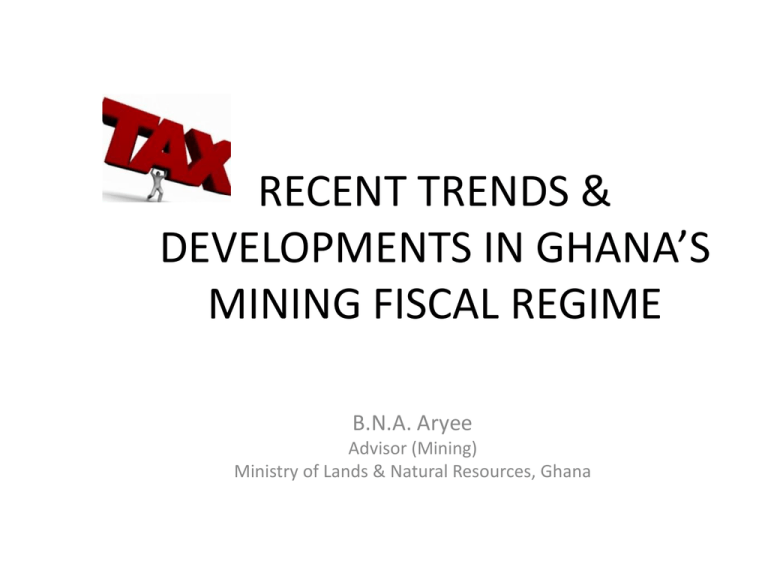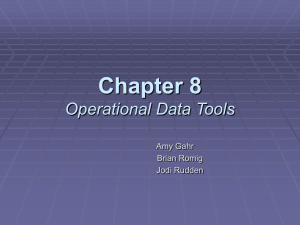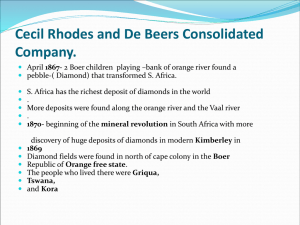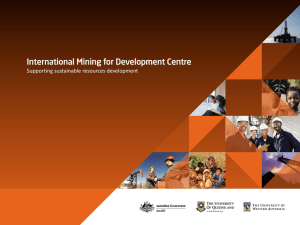TWN_Fisc Present_01
advertisement

RECENT TRENDS &
DEVELOPMENTS IN GHANA’S
MINING FISCAL REGIME
B.N.A. Aryee
Advisor (Mining)
Ministry of Lands & Natural Resources, Ghana
PRESENTATION OUTLINE
• Background & Introduction
• Rationale for Recent Mining Fiscal Regime
Reform
• Recent Trends in Ghana’s Mining Fiscal Regime
• Other Developments
• Guidance Questions & Answers
BACKGROUND & INTRODUCTION
• Ghana is a significant gold producer in Africa
(second after South Africa) and globally, being
the 9th largest producer in the world.
• In 2013, Ghana produced about 4.3 million
ounces of gold, only a marginal decline from the
2012 highest ever production in the history of
the country,
MINING SECTOR OVERVIEW
• Investment inflows for mining from 1983 to 2013 was about US$13.7 billion
• Gold production for 2013 was 4.3 million ounces.
OVERVIEW: MINERAL PRODUCTION
OVERVIEW: MERCHANDISE EXPORTS
MINING SECTOR OVERVIEW
• The significant investment over the years and
consequently mineral outputs led to an increased
sector contribution to the economy of:
28% of Government revenue as collected by the
Ghana Revenue Authority in 2012
Export revenues from the mineral sector amounted
to US$5.1 billion in 2013 & accounted for
42% of total merchandise export in 2012
Employed 28,000 for large scale and estimated over 1
million people for small scale mining.
RATIONALE FOR THE RECENT REVIEW
OF THE FISCAL REGIME 1
Speaking at the recent World Economic Forum in
Davos, Switzerland on challenges in the mining sector,
President John Mahama explained that Ghana is
having
“issues
with the big mining companies
that have stability agreements that
locked in the level of royalties and taxes
for us. So when gold prices rose up to a
record high we could not earn more.”
•
http://business.peacefmonline.com/pages/news/201401/186799.php
RATIONALE FOR THE RECENT REVIEW
OF THE FISCAL REGIME 2
• “During the recent … prices of gold, … reached their peak
levels ever. Yet the country did not benefit at all from the
price hikes, particularly from gold,”
• economic and social benefits provided by the mining sector
did not match government’s expectations, hence its decision
to review the industry’s taxes • the issue with mining was … fair and transparent sharing of
benefits and windfall gains from the exploitation of the
country’s precious and irreplaceable natural resources.
Thus, government is taking a bold step to critically review the
fiscal regimes and mining agreements, with the view of ensuring
that the country benefited adequately and fairly from the gains
in the mining sector.
- Dr Edward Larbi-Siaw, Tax Policy Advisor of the Ministry of Finance; (May 2013)
RECENT TRENDS IN GHANA’S FISCAL REGIME
ITEM
SMCD 5, PNDCL 153,
1975
1986
Pre-prdn Cost
Capitalization
& Capital
Allowances
20%
initial;
then
15% DB
Investment
Allowance
AMENDMENTS
TO PNDCL 153
75% initial;
then 50% DB
5%
5%
ACT 703,
2006
AMENDMENTS
75% initial;
then 50% DB
20% SL
TO ACT 703
5%
Loss CF
Up to 5 Yrs
Up to 5 Yrs
Forex
Retention
[25-80%]
[25-80% -20%
Offshore
Onshore]
Import Duties
Exempt (*)
Exempt (*)
3-6%
5% {Act 794}
25%
35% [mining]
Royalty
6%
6-12%
Corp Inc Tax
50-55%
45%
APT /WFPT
*
25% on 35% IRR
35%
{10% proposed)
plant, machinery and equipment imported exclusively and specifically for Mining
RECENT TRENDS IN GHANA’S FISCAL REGIME
ITEM
SMCD 5, PNDCL 153, 1986
1975
AMENDMENTS
TO PNDCL 153
ACT 703,
2006
AMENDMENTS
TO ACT 703
Withholding
Tax
10%
10%
15%
Capital Gains
Tax
10%
10%
15%
National
2% of pretax
profits(2001)
Reconstruction
Levy
Equity
Participation
10% free carried
Interest ;
+ option of 20%
shares at mkt price
10% free
carried
interest
Stabilization
Deed of Warranty
on Ltd Fiscal Terms
broad
Stability
& Devt
Agreements
Revised Fiscal Provisions
• During 2010 - 2012:
– royalty rate increased from a sliding 3-6 per cent to a
fixed 5 per cent rate;
– corporate tax rate was increased from 25 to 35 per
cent;
– Capital gains & Withholding taxes: 15%, up from
10%;
– 80%, then 50% Declining Balance Capital Allowance;
replaced by uniform 20% for 5 years regime; and
– windfall profit tax at a rate of 10 percent for all
mining companies was proposed, but shelved
Other Developments
• Improving “Arms-length” Dealings Framework – Transfer
Pricing Regulations; L.I. 2188, 2012
• Renegotiation of “Stability” Agreements, for simplification,
clarity, and equity;
• Amendment of Minerals and Mining Act, Act 703 of 2006,
under way (& further Amendments being considered);
• Formalization of Community Interests – MDF legislation almost
ready for Parliament;
• Improved Stakeholder Engagement, for transparency and good
governance, e.g. EITI ;
• Active Involvement in REC (ECOWAS) policy & legislation
harmonization drives; also Continental (AU/UNECA) Initiatives;
• Ghana’s Application to AMDC to support its adoption of CMV
process.
SOME GUIDANCE
QUESTIONS
&
ANSWERS
Which elements of the reform package attracted the
strongest reactions from the mining companies & why?
• Mining firms blackmail Ghana over windfall profit tax
President John Mahama told the World Economic Forum in Davos
… that his government has not been able to implement the policy
due to threats from the mining companies.
• “They threatened to lay off workers if we implemented the
windfall tax and because we needed the jobs and you don’t
want workers laid off you are coerced to go along. So these
are major issues we have, … They will not allow us to
implement a windfall tax in our country”, President
Mahama said.
• “BAD” TIMING; GOLD PRICE DIPPED SOON AFTER PROPOSAL.
http://sankofaonline.com/mining-firms-blackmail-ghana-over-windfall-tax-4700-illigal-miners-deported-mahama/
Which elements of the fiscal reforms proved
most difficult to implement and why?
• Ring-fencing provision
• Act 839 (2012) had a provision requiring mining
companies to match expenses from one Mining Area
to revenue from the same mining area; but Mining
Area as defined by the Mineral and Mining Act, 2006
Act 703 was not for tax purposes & impeded
implementation.
• INADEQUATE CONSULTATION AMONGST AGENCIES
Would you regard the fiscal reform exercise as having
met its objectives?
Yes, as shown below, Royalty collections rose dramatically
between 2010 & 2012 due to the increase in rate, but
impact was dampened in 2013 due to the fall in gold prices.
Corporate taxes also improved due to the application of
new tax rates and capital allowance.
YEAR
2013
MINERAL ROYALTY
GHC
364,673,038
CORPORATE TAX
GHC
518,545,259
2012
359,392,853
893,773,828
2011
2010
222,027,706
144,697,345
649,902,536
241,578,780
What are the main lessons that you draw from Ghana’s
mining fiscal reforms?
To achieve and sustain the gains:
• Need for adequate stakeholder consultations to have the
desired impact
• Government should be more proactive and react quickly to
the changes in the mining industry, e.g. Government would have
benefited more from gold price hikes if reforms were undertaken earlier,
say btn 2008-09
• Fiscal reforms should also aim at maximising revenue without
necessarily increasing taxes eg. By facilitating (i)Broadening tax base;
(ii)Diversifying mineral resource base; (iii)Enhanced value addition,
beneficiation and local content & linkages in general.
• Need to fashion suitable and sustainable tax system to meet
the needs of small scale miners.
THANK YOU
FOR
YOUR ATTENTION
20







